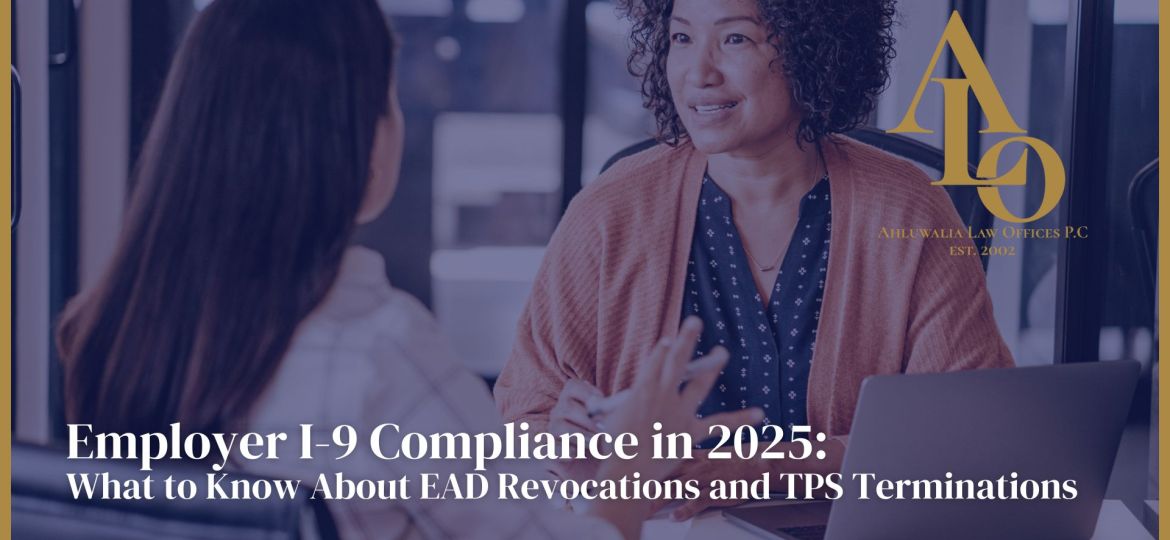
In the evolving landscape of U.S. immigration enforcement, employers face new complexities in maintaining I-9 compliance—especially in light of recent changes to employment authorization policies. The Department of Homeland Security (DHS) has announced large-scale revocations of Employment Authorization Documents (EADs) linked to parole programs and Temporary Protected Status (TPS), creating unique challenges for U.S. businesses.
This blog will guide employers, HR teams, and legal counsel on how to navigate these challenges while staying compliant with federal law.
The Changing Immigration Landscape
Since March 2025, the Trump Administration has prioritized revoking work authorization for hundreds of thousands of individuals who were legally present in the United States under humanitarian parole programs like CHNV (Cuban, Haitian, Nicaraguan, and Venezuelan parole) and various TPS designations.
Key federal actions include:
- Termination of CHNV Parole: DHS rescinded humanitarian parole for CHNV recipients, immediately affecting both their legal stay and their work authorization.
- Revocation of TPS: TPS protections have ended for countries including Venezuela, Afghanistan, Cameroon, Nepal, Haiti, Honduras, and Nicaragua. According to DHS, nearly 1.1 million individuals previously held TPS as of September 2024.
- EAD Revocations: DHS has begun systematically revoking EADs for impacted parole and TPS recipients.
The Compliance Challenge for Employers
Employers are now tasked with managing I-9 compliance while avoiding both civil penalties for employing unauthorized workers and potential discrimination claims under the Immigration and Nationality Act (INA).
E-Verify’s New “Status Change Report”
On June 20, 2025, E-Verify introduced a Status Change Report to alert employers about employees whose parole- or TPS-based EADs may have been revoked. However, this report presents significant compliance risks:
- The report does not include names, only A-Numbers.
- It lists anyone who has ever held a CHNV or TPS EAD, not just current EAD holders.
- DHS recommends employers cross-reference the report with internal Form I-9 records before taking action.
Actual vs. Constructive Knowledge
Under federal regulations, employers may face liability for continuing to employ unauthorized workers if they possess:
- Actual Knowledge: Direct confirmation from the employee or government notification.
- Constructive Knowledge: Circumstances that would lead a reasonable employer to know the employee is unauthorized. Examples include:
- Ignoring expiration dates on Form I-9 documents.
- Receiving notification from DHS through the E-Verify Status Change Report.
- Accepting inconsistent or suspicious documentation.
Key Employer Obligations
For E-Verify Employers:
- Run the Status Change Report Regularly: While DHS has not defined “regular,” employers should adopt a documented internal review schedule—daily, weekly, or monthly depending on the business size and risk.
- Reverify Promptly: Use Form I-9 Supplement B to reverify affected employees. Follow company policy or work with legal counsel to create a protocol if one does not exist.
- Protect Employee Privacy: Handle A-Number data with strict confidentiality using secure systems, as required by data privacy laws.
For Non-E-Verify Employers:
- Monitor Internal Records: Since non-E-Verify employers do not receive DHS status reports, internal audits are recommended but must be carefully managed to avoid discriminatory practices.
- Stay Informed: Regularly review the DHS EAD Revocation Guidance webpage and USCIS updates.
How Much Time Should Employers Provide for Reverification?
There is no federal mandate on how long an employer must give an employee to present alternative work authorization. However:
- The process should be reasonable, consistent, and well-documented.
- ICE has a 10-day guideline for Notices of Suspect Documents, but this does not apply to internal audits or E-Verify reverifications.
- Employers should consider factors such as document availability and the time needed to obtain new authorization.
Risks of Noncompliance
Employers face multiple risks if they fail to properly navigate this new enforcement environment:
- Form I-9 Noncompliance: Penalties for errors or failure to reverify.
- Unlawful Employment: Civil or criminal penalties for knowingly employing unauthorized workers.
- Discrimination Claims: Risks under INA § 274B for unfair documentary practices or discriminatory actions.
- Privacy Violations: Mishandling sensitive information during compliance checks.
- Fraudulent Documentation: Employers must be vigilant in document verification during reverification.
Best Practices for Employers
To protect your business while staying compliant:
- Establish Clear Policies: Create or update internal protocols for running E-Verify reports, reverifying employees, and documenting actions.
- Consult Legal Counsel: Work with immigration attorneys to ensure that your policies align with both federal law and your business needs.
- Maintain Consistent Treatment: Apply the same verification standards to all employees to avoid claims of discrimination.
- Document Everything: Keep records of all compliance actions, including reports run, employees reverification status, and communication logs.
- Train Your HR Team: Ensure staff are educated on current Form I-9 requirements and reverification procedures.
Final Thoughts
As federal immigration policies continue to shift, employers must balance workforce stability with strict compliance to federal hiring laws. At Ahluwalia Law Offices, we help corporate clients across the U.S. develop strategies to meet these challenges, minimize risks, and ensure lawful employment practices.
Contact our office to schedule a consultation regarding your company’s I-9 compliance protocols.

